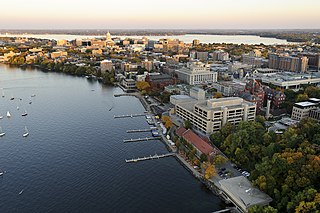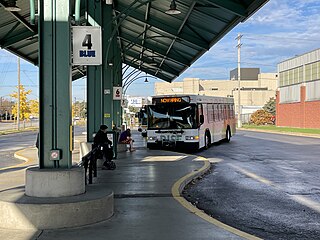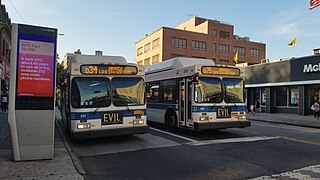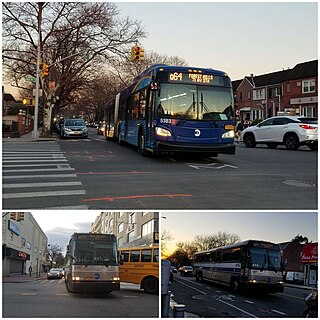
Madison is the capital city of the U.S. state of Wisconsin and the county seat of Dane County. As of the 2020 census, the population was 269,840, making it the second-most populous city in Wisconsin after Milwaukee, and the 80th-most populous in the United States. The Madison metropolitan area had a population of 680,796. The city is located on an isthmus and lands surrounding five lakes—Lake Mendota, Lake Monona, Lake Wingra, Lake Kegonsa and Lake Waubesa. Madison was founded in 1836 and is named after American Founding Father and President James Madison.

Dane County is a county in the U.S. state of Wisconsin. As of the 2020 census, the population was 561,504, making it the second-most populous county in Wisconsin after Milwaukee County. The county seat is Madison, which is also the state capital. Dane County is the central county of the Madison, Wisconsin, Metropolitan Statistical Area, as well as the Madison-Janesville-Beloit Combined Statistical Area.

Fitchburg is a city in Dane County, Wisconsin, United States. The population was 29,609 at the 2020 census. Fitchburg is a suburb of Madison and is part of the Madison Metropolitan Statistical Area. Fitchburg consists of a mix of suburban neighborhoods closer to the border with the city of Madison, commercial and industrial properties, and more rural properties in the southern portion of the city.

La Crosse is a city in and the county seat of La Crosse County, Wisconsin, United States. Positioned alongside the Mississippi River, La Crosse is the largest city on Wisconsin's western border. La Crosse's population was 52,680 as of the 2020 census. The city forms the core of the La Crosse–Onalaska metropolitan area, which includes all of La Crosse County and Houston County, Minnesota, with a population of 139,627.

King County Metro, officially the King County Metro Transit Department and often shortened to Metro, is the public transit authority of King County, Washington, which includes the city of Seattle. It is the eighth-largest transit bus agency in the United States. In 2023, the system had a ridership of 78,121,600, or about 256,200 per weekday as of the fourth quarter of 2023. Metro employs 2,444 full-time and part-time operators and operates 1,540 buses.

Dane County Regional Airport (DCRA), also known as Truax Field, is a civil-military airport located 6 nautical miles northeast of downtown Madison, Wisconsin. In the Federal Aviation Administration (FAA) National Plan of Integrated Airport Systems for 2023–2027, it is one of 2 airports in Wisconsin that is categorized as a small-hub primary commercial service facility; the other is Appleton International Airport. It is the second busiest of eight commercial airports in Wisconsin in terms of passengers served, after Milwaukee Mitchell International Airport.

Waukesha Metro Transit is a public transit agency operating in the city of Waukesha and throughout Waukesha County. Founded in 1981, the system directly operates ten bus routes, contracts three commuter routes to Wisconsin Coach Lines, and partially funds two routes of Milwaukee County Transit System which extend into Waukesha County.

Green Bay Metro is the mass transit system found in the city of Green Bay, Wisconsin. It also provides service in Ashwaubenon, Allouez, De Pere, and Bellevue. In 2023, the system had a ridership of 832,900, or about 3,400 per weekday as of the fourth quarter of 2023.

The B68 is a bus route that constitutes a public transit line operating in Brooklyn, New York City. The B68 is operated by the MTA New York City Transit Authority. Its precursor was a streetcar line that began operation in June 1862, and was known as the Coney Island Avenue Line. The route became a bus line in 1955.

Select Bus Service is a brand used by the Metropolitan Transportation Authority (MTA)'s Regional Bus Operations for limited-stop bus routes with some bus rapid transit features in New York City. The first SBS route was implemented in 2008 to improve speed and reliability on long, busy corridors.

MTA Regional Bus Operations (RBO) is the surface transit division of the Metropolitan Transportation Authority (MTA). It was created in 2008 to consolidate all bus operations in New York City operated by the MTA. As of February 2018, MTA Regional Bus Operations runs 234 local routes, 71 express routes, and 20 Select Bus Service routes. Its fleet of 5,840 buses is the largest municipal bus fleet in the United States and operates 24/7. In 2023, the system had a ridership of 730,924,600, or about 2,309,600 per weekday as of the fourth quarter of 2023.

MetroBus is a public bus service operated by Metro Transit that serves the Greater St. Louis area. In 2023, the service had an annual ridership of 12,531,400, or about 39,400 per weekday as of the fourth quarter of 2023.

Eau Claire Transit is a mass transportation provider in Eau Claire County, Wisconsin. The system consists of fifteen core routes and is served by a fleet of 22 low-floored buses. Service frequency varies from thirty minutes to one hour depending on the route and time of day. There is no service on Sundays or Saturday evenings.

The Q60 bus route constitutes a public transit line running primarily along Queens Boulevard in Queens, New York City, extending from Jamaica, Queens, to Midtown Manhattan via Queens Boulevard and the Queensboro Bridge. It is city-operated under the MTA Bus Company brand of MTA Regional Bus Operations.

The Q25 and Q34 bus routes constitute a public transit line in Queens, New York City. The south-to-north route runs primarily on Parsons Boulevard and Kissena Boulevard, serving two major bus-subway hubs: Sutphin Boulevard–Archer Avenue–Jamaica and Flushing–Main Street. The Q25 terminates in College Point, and the Q34 in Whitestone, both in northern Queens.

The Q64, QM4 and QM44 bus routes constitute a public transit line in Queens, New York City. The east-to-west Q64 route runs primarily on Jewel Avenue operating between the Forest Hills–71st Avenue subway station in Forest Hills and 164th Street in Electchester. The QM4 route is an express bus route running from Midtown Manhattan to Electchester running via Sixth Avenue in Manhattan and Jewel Avenue in Queens. The QM44 route is an express bus route running from Midtown Manhattan to Electchester via Third Avenue in Manhattan and Jewel Avenue in Queens.

The Bx23 and Q50 bus routes constitute a public transit corridor in New York City, running from the Flushing neighborhood in Queens to the Pelham Bay and Co-op City neighborhoods in the Bronx. The Bx23 provides local service in Pelham Bay and Co-op City, while the Q50 provides limited-stop service between Co-op City and subway hubs in Pelham Bay and Flushing. Both routes are city-operated under the MTA Bus Company brand of MTA Regional Bus Operations, and are the only two local routes in the Bronx to operate under the MTA Bus brand, rather than under the MaBSOTA brand that all other Bronx bus routes operate under.
Monona Express is a provider of mass transportation with commuter bus service between Monona and Madison, Wisconsin. Since 2022, the city has studied whether to discontinue the service in favor of switching to Madison Metro Transit, which would streamline transfers and operations of transit services in the Monona area. As of December 2023 the Monona city council has elected to join the Metro Transit network and wind down the Monona Express service, Monona is slated to served by a new branch of the Metro "C" route as well as new stops along the existing "G" and "L" routes along Monona Dr which previously ran express through the city. A final date for Monona Express has not been established as of December 2023.
























